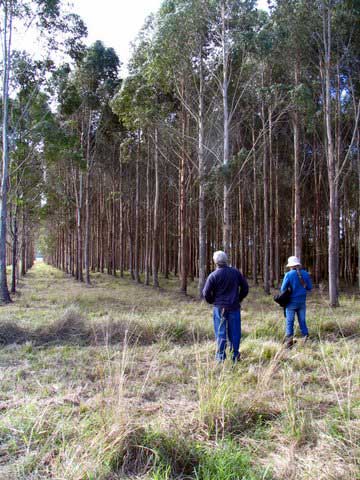June 2010 Field day
Over twenty people visited two properties in the lower Manning valley where the one owner has been developing extensive native planations for over thirty years. On the higher property the main species have been blackbutt and flooded gum, with most trees at an advanced stage. On the more low lying property, as well as flooded gum, swamp mahogany, tallowwood and blackwood have been planted. Frost damage has occcurred to the latter two species, although the tallowwood especially are recovering. The flooded gum have performed differently on different sites, with varying drainage conditions a likely important factor. Preparations for planting involved ripping and forming linear mounds in which to plant tube stock. A planting rate of up to 1000 trees per day has been achieved by the farmer working alone. Maintenance activities have included pruning, slashing between the rows, brushcutting between trees in a row and controlled grazing.
March 2010 Field day
A property on the alluvial flats of the Crawford River was visited. It had previously been a dairy farm and a vegetable market garden. A Paulownia plantation had been established prior to the current owner taking over about four years ago, with the plantation size increased since then. We inspected trees at different stages of their life cycle and different planting and management methods. There was an interesting discussion of drying and marketing the timber. The property also had an area close to the river of recent plantings of native trees. After a hike over elevated parts of the property to view areas proposed for bush food crops we dashed through the driving rain to shelter, lunch and the formal meeting, including discussion on the recent Private Native Forestry initiatives.
November 2009 Field day
The venue for the November field day was changed at the last minute, because the miller no longer had a mill. The day was held at a biodynamic farm which has just established a small plantation. We inspected the plantation and many other plantings on the farm, including some very impressive river bank replanting. We were driven inside by some rain and forced to have an AGM and plan for 2010. a pleasant way to cap off another year.
September 2009 Field day
On Saturday a small but enthusiastic crew visited a site at Howes Valley with a known fire history for the last 30 years. We cut cross sections through a fallen tree and carefully cut epicormic shoots away from the bark to examine the effect of fire on the timber.
On Sunday a large crowd listened to an expose on fire shelters, fine furniture and paulownia trees at Wollombi. Afterwards we were taken for a walk into a nearby forest where there is a HUGE iron bark – much bigger than any other known ironbark tree. A fascinating day with some excellent repartee.
July 2009 Field day
An interesting day reviewing a previous field day site at Maitland Vale. The site was part of a thinning and plantation trial. Thinning trial was remeasured with a pleasing result showing the basil area had returned to the pre-thinning value after approximately 6 years. Meanwhile, down in the plantation, there was a pruning tool shoot out with the chain saw pole pruner facing up to the pole saw and electric pole pruners. Predictably, each had strengths and weaknesses. The day ended with a tree planting session on the creek where the June 2007 flood had removed previous plantings. A well attended and enjoyable day.
June 2009 Field day
A well attended meeting with the usual flair for turning out a fine feed for morning tea and lunch. A particular prize to our host member for the innovative water boiler. Our host walked us through the trials and tribulations of preparing property vegetation plans and obtaining permission to log a private native forest. This was followed by an inspection of the proposed logging area and lively discussion on the operations plan and the code. An interesting and stimulating meeting.
April 2009 Field day
Unfortunately postponed till 14 June.
March 1st 2009
CMA held a Carbon day at Maitland. About a dozen HFFN members attended. A stimulating day with top speakers on Carbon Credits and Bio Banking. The day ended with a walk through the nearby Earth Care Park plantation. Some HFFN members adjusted their age and rode mountain bikes around the BMX track instead of afternoon tea, while others did the “Water Watch” thing. A good day and thanks to Graham from the CMA.
November 2008 Field Day
A freezing cold November day on top of a mountain, but a fascinating day none the less. In amongst the planted rainforest it was still and mild. A fantastic effort to push back the Lantana and agricultural weeds and plant a magnificent and diverse rain forest. The day finished off for some by a visit to the local 60m waterfall. Wow. Oh, we also did the AGM thing and re-elected the 2008 committee unopposed.
August Field day 2008 Report
The field day at Kooragang city farm was a fascinating day – with lots of wisdom thrown in
“Wire Grows grass”
“Graze cows to grow good grass”
In the Kooragang wetland, the best trees grow where they are planted with many plants to the square metre.
Planting is at any time of year. Preparation is by allowing everything to grow out of control and then spaying and allowing it to mulch down. Ripping is not needed in the wet soil. A small army of volunteers turn out each third Sunday of the month to do a mornings planting and then have a relaxed lunch.
